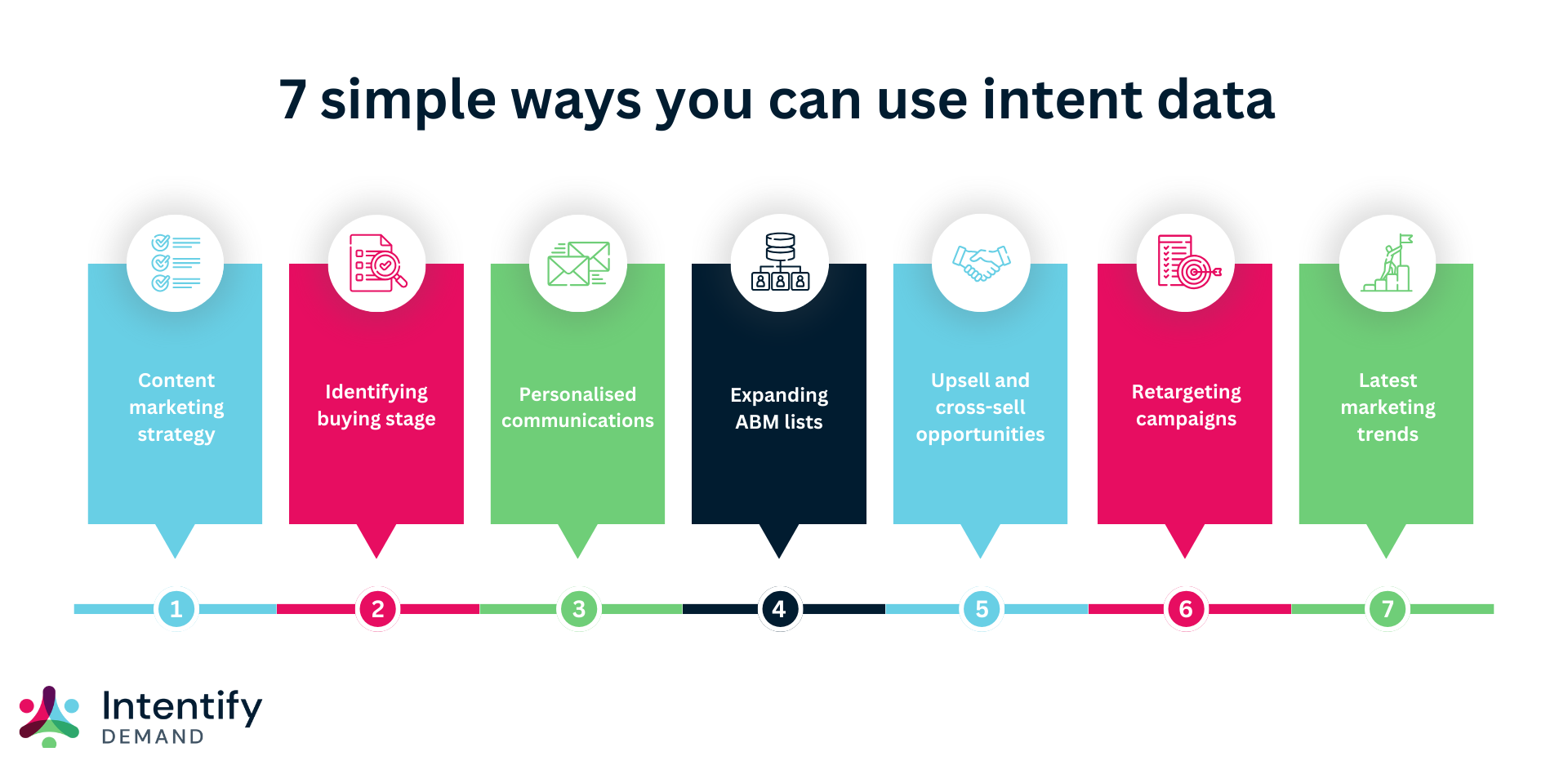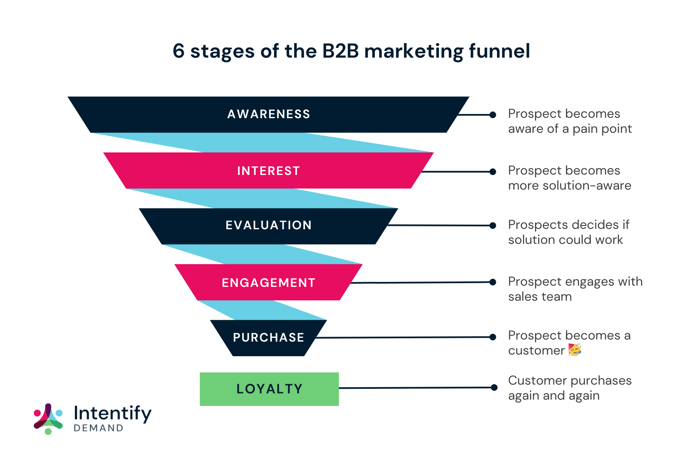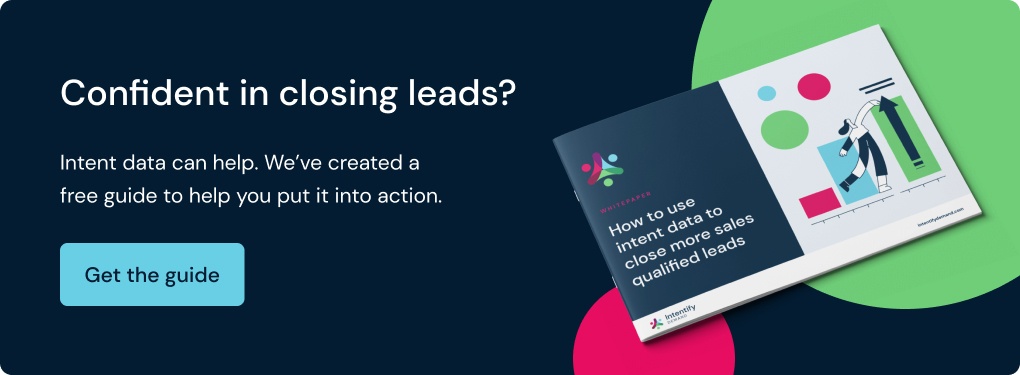Read time: 8 minutes
As we know, the marketing landscape is always evolving; driven by advances in technology, ever-changing consumer expectations, globalisation and a shift towards ethics and social responsibility.
Do you ever just wish it would stop for a moment to let you catch up?
Sorry, but there’s no time to rest as intent data is set to be the go-to marketing tool of the 2020s.
As each business has its unique characteristics, its intent data is also equally unique. Intent is not a fix-all solution but it does serve as a valuable tool that can help marketing and sales to extract more value from their leads.
- Holly Jones, Marketing Manager
Over the last few years, it has already become a critical tool for many marketing professionals and the sales teams they support, with around 40% of businesses already dedicating over half of their marketing budget to intent data.
Of those, almost 70% are planning to increase this spending in the next couple of years.
And with good reason.
When used effectively, intent data can provide valuable insights into the actions and behaviours of your target audience, improving the effectiveness of your marketing campaigns.
The trouble is, getting the right tools and an effective intent data strategy in place requires a significant investment of time, resources and yes, money.
But with almost three-quarters (73%) of B2B marketers already rolling out an intent data strategy in their business right now, you can't afford to be left behind.
That being said, leveraging intent data doesn't have to be a struggle. In fact, there are some simple but effective ways you can use intent data in your marketing campaigns this year.

1. Shape your content marketing strategy
83% of marketers are already using intent data to create relevant and interesting content that aligns with key customer behaviours.
And you can do the same.
Understanding intent data can greatly impact your website strategy. It enables you to make adjustments and create pages tailored to frequent high-intent visitors, enhancing user experience and providing the valuable information that potential customers need.
- Holly Jones, Marketing Manager
Intent data can help you shape your content marketing strategy, allowing you to create the perfect content for your target audience. This could include everything from blog posts, web content and whitepapers to social media and other digital content.
Armed with these insights, you can produce a variety of content that addresses the specific needs and interests of your audience, on whichever channel they favour.
For example, using intent data you can create custom audiences on social media and then tailor your ad content accordingly. Alternatively, you might use intent data to dynamically change the copy on your website based on visitor behaviour and needs.
Continuously producing content that addresses specific intent behaviours in this way can help you position your brand as a relevant and authoritative source in the market.
2. Identify which buying stage a prospect is at
Intent data is all about a deeper understanding of your target audience and helping them with what they need. Being able to track and predict online behaviours means that you're able to deliver relevant content at the right time, whether this is through email nurture campaigns or social media targeting. Not only is this more effective in terms of conversion rates, it also means that you can allocate marketing resource in the best possible way.
So by using B2B intent to understand your target audience, you can determine at which stage they're at in the marketing funnel and therefore how to nurture them.
For example, if a prospect is downloading a case study and looking to book a product demo, they're likely to be pretty far into their buying journey and are ready to engage with a sales rep.

3. Provide targeted and personalised communications
Insights gathered using intent data can help marketing teams provide consumers with targeted and personalised communications.
This is crucial to the customer experience and over three-quarters (80%) of consumers agree that they're more likely to buy from a brand when provided with personalised experiences.
With that figure in mind, personalisation should also be an important part of your content marketing strategy.
Intent data plays an important role in refining targeting strategies. It allows you to pinpoint the buyer groups showing the most interest – these are the ones that you want to focus on. Email marketers in particular should rely on it to create highly relevant lead-nurturing campaigns. It provides insights into which prospects require more nurturing and which are ready for a more direct Call to Action.
- Holly Jones, Marketing Manager
By leveraging intent data effectively, you can gain a deeper understanding of your customer’s pain points, enabling you to produce targeted and personalised strategies that address those needs.
For instance, if a prospect has been researching a particular feature of your products, you can highlight that feature through targeted communications like social media adverts or an email campaign. This type of personalised messaging is incredibly valuable in driving conversion rates and showcasing how you, as a business, understand the needs of your customers.
4. Expand your ABM list with intent-based signals
Over two-thirds (67%) of brands already leverage account-based marketing (ABM), but these strategies can be enhanced even further using intent-based signals.
These signals help to identify those in an active buying cycle and let you know what stage they are at.
This can help your marketing team to identify and prioritise those high-value accounts based on their latest searches, as well as understand what issues prospects are most concerned with. Creating your ideal customer profile this way by leveraging intent signals can help to create a more accurate idea of who you're targeting, while also helping you to discover new accounts.
You can reimagine your ABM programs to define targets and prioritise these accounts. Which, in turn, allows you to develop tailored content and launch targeted marketing campaigns accordingly.
5. Find upsell and cross-sell opportunities
We all know the importance of nurturing the relationship with a current customer to keep them coming back for more. But as the market becomes more competitive, this is becoming harder.
You can then use customer segmentation and personalisation to tailor your upsell and cross-sell marketing strategies.
Of course, there are lots of ways you can do this, but we promised simple, so why not start by promoting new featured products or offer exclusive discounts to return customers?
However, it's important to approach these interactions with care and consideration. Rather than being pushy or overly sales-oriented, focus on understanding the customer's needs and offering tailored solutions that genuinely benefit them. By adopting a consultative approach, you build trust with the customer and increase the likelihood of successful upsells or cross-sells.
6. Run retargeting campaigns
Retargeting campaigns can be one of the most effective (and budget-friendly) ways to increase sales.
It’s all about giving prospective buyers that gentle little nudge back to your web pages.
By reaching out to those who have already expressed an interest in your brand, you can boost your visibility and increase the chance of them completing portable actions in the future.
And intent data can be extremely helpful for these campaigns too. In fact, research shows that intent-based ads have a 220% higher click-through rate than traditional ones.
These insights allow you to implement dynamic retargeting adverts that display products or content that prospective customers have already shown an interest in.
Again, enticing them back to your website or relevant digital platforms and encouraging them to complete the desired action.
7. Stay up to date on the latest marketing and industry trends
Last but certainly not least, if you can understand what’s hot in the market right now, then your team can quickly pivot your marketing efforts to capitalise on this.
Intent data can be a great tool for staying ahead of new marketing trends, so you can react before these opportunities become too saturated.
Through gathering and analysing these insights, you can uncover what topics or products potential customers are actively searching for or engaging with online.
This enables you to make agile decisions and respond promptly to shifts in customer preferences, ensuring that your messages are relevant and timely, increasing the likelihood of conversion.
Tailoring your marketing efforts based on intent data also allows you to focus your resources on the areas that are currently generating the most interest.
It's time to make intent data your go-to source
Whether you're looking to improve our current marketing efforts or put new strategies in place, intent data should be the go-to source for B2B marketers. It's a powerful tool when used correctly, and can go a long way in turning potential buyers into paying customers.
Providing valuable insights to help guide decision-making and engage best-fit prospects is much easier with the power of intent. The only thing left to do is implement it into your everyday activities to start seeing the results.



